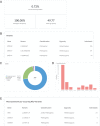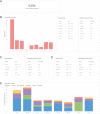A scalable, aggregated genotypic-phenotypic database for human disease variation
- PMID: 30759220
- PMCID: PMC6372842
- DOI: 10.1093/database/baz013
A scalable, aggregated genotypic-phenotypic database for human disease variation
Abstract
Next generation sequencing multi-gene panels have greatly improved the diagnostic yield and cost effectiveness of genetic testing and are rapidly being integrated into the clinic for hereditary cancer risk. With this technology comes a dramatic increase in the volume, type and complexity of data. This invaluable data though is too often buried or inaccessible to researchers, especially to those without strong analytical or programming skills. To effectively share comprehensive, integrated genotypic-phenotypic data, we built Color Data, a publicly available, cloud-based database that supports broad access and data literacy. The database is composed of 50 000 individuals who were sequenced for 30 genes associated with hereditary cancer risk and provides useful information on allele frequency and variant classification, as well as associated phenotypic information such as demographics and personal and family history. Our user-friendly interface allows researchers to easily execute their own queries with filtering, and the results of queries can be shared and/or downloaded. The rapid and broad dissemination of these research results will help increase the value of, and reduce the waste in, scientific resources and data. Furthermore, the database is able to quickly scale and support integration of additional genes and human hereditary conditions. We hope that this database will help researchers and scientists explore genotype-phenotype correlations in hereditary cancer, identify novel variants for functional analysis and enable data-driven drug discovery and development.
Figures




References
-
- Nagy R., Sweet K. and Eng C. (2004) Highly penetrant hereditary cancer syndromes. Oncogene, 23, 6445–6470. - PubMed
-
- Lichtenstein P., Holm N.V., Verkasalo P.K. et al. (2000) Environmental and heritable factors in the causation of cancer—analyses of cohorts of twins from Sweden, Denmark, and Finland. N. Engl. J. Med., 343, 78–85. - PubMed
Publication types
MeSH terms
Substances
LinkOut - more resources
Full Text Sources
Molecular Biology Databases

